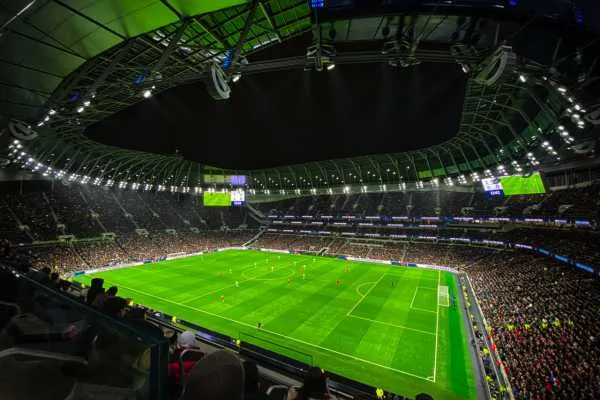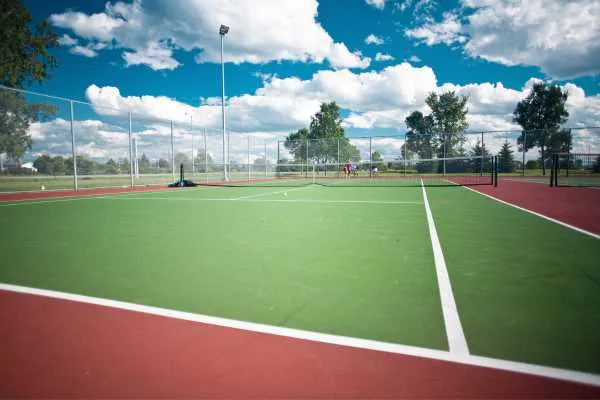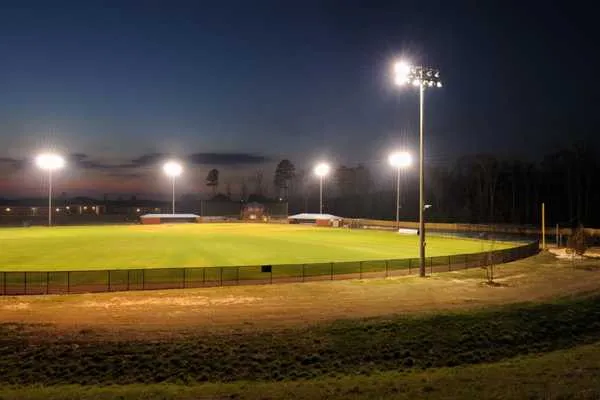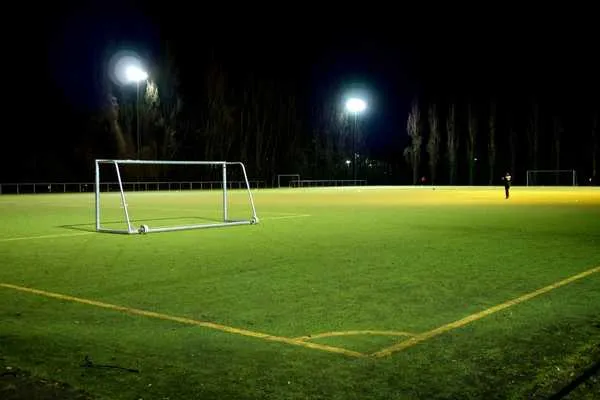Sportsvenuecalculator.com is a free resource dedicated to helping sports facility planners.
Did our site support your project?
Leave a quick testimonial to help us keep assisting others like you!
Learn the basics of LED sports lighting and the major aspects that project planners ought to be aware of before they set out on their journey toward better illumination in their sport facility.


LED outdoor sports lighting delivers superior brightness, energy efficiency, and reliability, offering instant, uniform light with no warm-up time. Ideal for fields, courts, and arenas, its long lifespan and low maintenance make it the top choice for enhancing visibility and safety in various sports applications.
LED indoor sports lighting provides excellent brightness, energy efficiency, and reliability, delivering instant, uniform light without warm-up time. Perfect for gymnasiums, indoor courts, and arenas, its long lifespan and low maintenance make it the preferred solution for enhancing visibility and safety in various indoor sports settings.

We’ve created a comprehensive set of tools designed to assist facility managers and project planners in initiating their projects and connect them with the professionals in the industry.
Try our LED sports lighting cost calculator and get a customized quote in a matter of minutes.
Give us the specs of your LED sports lighting project and get a list of recommended suppliers from our network.
Browse through our grants database and find potential funding opportunities for your LED sports lighting project.
Browse through our grants database and find potential funding opportunities for your LED sports lighting project.
The cost of LED sports lighting reflects its superior brightness, energy efficiency, and durability. While the initial investment may be higher, LED lighting’s long lifespan, low maintenance, and reduced energy consumption make it a cost-effective choice for enhancing visibility and safety across various sports facilities.


LED sports lighting retrofits offer a cost-effective way to upgrade existing lighting systems with superior brightness, energy efficiency, and reliability. By replacing outdated fixtures with long-lasting LED technology, facilities can improve visibility, reduce maintenance, and lower energy costs, all while enhancing the overall safety and performance of sports venues.
LED sports lighting grants provide valuable financial support for upgrading to energy-efficient LED systems. These grants help facilities offset the initial costs, making it more affordable to enhance visibility, reduce energy consumption, and improve safety with advanced LED lighting solutions across various sports venues.


LED lighting is becoming increasingly popular for sports facilities due to the many benefits over traditional lighting sources. Suppose you are considering upgrading your facility to LED lighting. In that case, it is crucial to choose a reputable and experienced lighting company to ensure a successful installation or retrofit project.
LED sports lighting design focuses on creating optimal lighting solutions that maximize visibility, energy efficiency, and safety. Through careful planning and selection of fixtures, a well-designed LED system ensures uniform, high-quality illumination tailored to the specific needs of sports venues, enhancing both the playing experience and overall facility performance.

If you're planning to install or retrofit an LED sports lighting system, our comprehensive buyer's guide covers all the essential aspects including planning, budgeting, design, installation, and post-installation considerations, simplifying your decision-making process.
Get the Free Guide
Color rendering index (CRI) measures how accurately the sports lighter renders colors of objects versus a natural light source. The higher the CRI, the better. LED sports lighters (85+) outscore conventional HID lights (70+) by a wide margin when it comes to CRI.

Lumens per watt (LPW) is the go-to metric when it comes to lighting efficiency. LEDs put out 100-150 lumens per watt, whereas, HID lighters can only reach 100 LPW. Taking into consideration the fact that HID fixtures depreciate with time, it’s safe to say this is a blowout win for LED.

LED sports lighters don’t contain toxic materials like mercury which is difficult to dispose of. Thanks to its lower temperature, LED lighting doesn’t pose a risk for fires or explosions. LED lighting is also better for your eyes, skin, and fabrics thanks to substantially reduced ultraviolet radiation.
Sports facility planning and feasibility are crucial for sports lighting projects, ensuring the design meets specific needs, budgets, and regulations. Proper planning helps optimize lighting performance, safety, and energy efficiency, leading to successful, cost-effective installations.

Here, we’ve gathered the most common questions and expert answers about LED lighting solutions for sports facilities. Whether you’re exploring options for a new installation, considering an upgrade, or just curious about the benefits and features of LED sports lighting, this section is designed to provide you with clear, comprehensive information. Dive in to discover everything you need to know about making your sports venue brighter, more energy-efficient, and future-ready with LED lighting technology.
These are just some of the most frequently asked questions, but you probably have others. Ask us, and on the off chance we don’t know the answer, we promise that we know someone who does!
The most basic questions in lighting design are: what are we lighting, and how big is it? You don’t need us to tell you that the larger the field, the more light you’ll need.
Knowing the dimensions of the playing field itself is not enough for designing a lighting system. Players, coaches and staff will use the area around the field; and some sports federations require a minimum amount of boundary area that has to be of the same surface and lighting as what’s inside the lines. This is a simple matter of safety: players can’t step into darkness every time they chase a ball out of bounds.
The size of the field and the neccessary luminance level will influence how many lighting fixtures you need. This question is closely related to how many light poles you’ll need, as well. Then there’s the intersection of those two factors: how many fixtures per pole?
As the planning process gets increasingly detailed (and it will), the system designers will consider the angle at which each fixture is aligned; how much light escapes from the fixture, and add-ons you can install to minimize scattered light; The one thing you can take as a solid going-in position is that LED lights offer so many advantages over conventional halide lamps that they are almost unanimously used across the sports industry.
Knowing that we can start going into the details. Read more about LED sports lighting fixtures in our buyer’s guide.
The number of lighting poles depends in part on the size of the field and how brightly it needs to be lit. Aside from how many, though, there are also questions of how tall, how sturdy, and precisely where around the field they will go.
The strength of each light and the amount of light scattered from the fixtures will impact the height of the pole. Taller poles are heavier, which means the height of the pole will affect the concrete foundation. Taller poles are also more susceptible to high winds and other extreme weather, which will also play into the sturdiness of the foundations and how the individual fixtures are attached to the poles.
The placement of the poles may also require you to expand your electrical infrastructure. If your current lighting system is all on one side of the field but your upgrades place new poles on the far side of the field, you may need to lay down the conduits and switching boxes to extend your power to those more distant poles.
Read more in our dedicated article about sports lighting poles cost and design considerations.
That’s often the first question facility managers and athletic directors ask. Unfortunately, answering it requires asking a handful of questions that should come first.
Walk out onto the field and ask yourself “If I were one of the players, how much light would I need right here, at this spot on the field, to play?” Sports field lighting directly affects player safety and performance. The luminance on the field must be adequate for them to see everything they need to see for their sport, whether that’s a 90 mph fastball coming at them from 60 feet away or a 45 yard pass arcing through the air towards the end zone.
Once the coaches have their say (and they should have a say), someone from the media or marketing team will say “How will that look on camera?” If you’re lighting a training facility, that won’t be as much of an issue. But if this is a competitive stadium, broadcast requirements may exceed the “playing requirements” for light levels.
From there, the engineers can map that luminance level across the entire field. Then they’ll ask “Where can we place the lighting fixtures?” That’s a function of how much run-out space you need to have around the field, sideline areas for the teams, spectator seating and maybe a track that will loop around a football or soccer field.
With that information in hand, the lighting designers can start to develop a menu of options for your lighting system. There may be a few systems that use a lower number of high-powered lamps, while others turn to a higher number of low-powered lamps.
So the unsatisfying answer to our question is: It depends… on a lot. Instead of an answer, we’d rather offer the piece of advice we started with: go out to the field and work backwards from there.
Read more about LED sports lighting fixtures in our separate article!
You want your sports field or complex to be a local landmark. You don’t want airplane pilots joking that they use your facility as a navigation aid because they can see the lights from miles away.
First off, you’re paying for all that light. Whether the photon goes to the field, down the street or out into space, it’s coming out of your pocket. When you see the hazy glow of a stadium over the horizon, think of it as a fountain of wasted money.
Second, scattered light is pretty annoying. Your neighbors won’t be too happy if they’re losing sleep because light from your fields is spilling into the bedroom. No can afford to jeopardize their relations with the local residential and business community. Reducing light spillage is an easy way to keep everyone happy.
While it might be easy to assume that all sports played outdoors would require a similar lighting setup, this is actually not the case. For example, NFL football stadiums require 2,500 lux(a metric related to lumen), while college football requires 1,500, and high school football requires 500. Stadiums use LED floodlights, which can be arranged in a row, or situated throughout the venue as needed to accommodate the sport. Beam angle, light pole height are other considerations to take into account, especially if the event is being televised.
Recommended lighting levels for soccer as similar to that of American football. However, extra attention should be paid to the corners of the field with regards to lighting. Corner kicks are prevalent in the sport, and often provide an offensive team with its best chance to score. As a result, lighting fixtures and beam angles need to take this into consideration.
Baseball/softball fields have different characteristics than football, both as a sport, and on the field itself. Rather than the rectangular shape of a football field, the baseball playing surface is shaped like a diamond. Additionally, the baseball itself is much smaller than a football, and is thrown and hit at players at a much higher speed. As a result, the illumination of the field, and in particular, the infield, needs to be sufficient for faster reaction time by the players. The recommendation is that an average of 50 horizontal footcandles(another brightness metric used in the U.S) be shined on the infield, while 30 horizontal footcandles be shined on the outfield.
LED sports lights have a number of advantages, such as long lifespan, design flexibility, instant lighting, and dimming capability. They would serve as the ideal option for high school and college facilities at this point in time, having replaced HID lights as the stadium standard.
High school and college stadiums typically use high-power LED floodlights. The wattage of these types of lamps varies quite a lot but generally falls between 300W-1000W. Dividing the number of lumens and the number of watts used to power one lumen can help provide a purchaser with the efficiency value of a lighting option i.e. the amount of visible light you get for a given amount of energy. The lumens per watt value has significantly increased in recent years thanks to great improvements achieved in LED technology. Stadium LED lamps generally speaking reach a range of 100 – 150 lumens per watt.
Estimating the strength of your lights is an interplay between how much space you need to light and where you are able to install the lighting fixtures.
If you have a low-capacity grandstand close to the field, the light poles can also be close to the field and do not need to be particularly high. This keeps down the cost of the poles and the cost of the lights, because fewer lux are needed.
However, if you have a 15,000-seat stadium with a grandstand on each side of the field and a track running between the field and the stadium, everything gets bigger: the area the light has to cover, the number of lux needed, the size and strength of the poles and the overall cost of the LED sports lighting system.
Much of the work that goes into determining the lighting requirements will have been completed when planning the field itself. The same considerations of sport, competitive level, and available space will shape what you need for the lighting system.
Once you have that information in hand and know the necessary illumination level, lighting system engineers can start developing options for providing that amount of light. They will balance things like the strength of individual lamps with the number of lamps per pole and the number of poles on the field. That, in turn, will affect the height of the poles and the tuning of each fixture on each pole.
They will also consider the electricity usage, and how much electricity the facility is capable of supplying to each pole. This is where finances and engineering begin to overlap: how much electricity will each arrangement need, how much can the facility deliver to each pole and how much will the costs of each option vary upfront and over time?
The delivery of a sports field lighting system can take anywhere between 1 and 12 weeks to deliver. A new installation can take the full 12 weeks if cabling and earthwork need to be done before putting up the light poles and installing the LED luminaires. On the other hand, if you are only replacing a few lighting fixtures, your project can be finished inside one week. Therefore, it is worth estimating beforehand how much time each step in the project takes and setting a clear schedule for the project. Typically schools or sports clubs install or replace their lighting systems during the off-season in order to have everything up and running before the new season starts in the fall.
This one is a bit more direct. Once again, let’s start at ground level. Literally, the ground.
How much work will you need to do to prepare the ground to support the sports field lighting system? You may need a soil survey to ensure you have an adequate foundation for the light poles (and the weight of the poles will be part of all that stuff we talked about in Question #1). If not, you may have to excavate and install sufficient gravel and dirt for the foundations to sit upon.
Another potentially significant part of site preparation is the electricity infrastructure. You’ll need a way to get the juice to the lights. Depending on what is already in place, powering up a new lighting system may entail installing the conduits, junction boxes and the like.
Next are the light poles themselves. Modern light poles are either metal, concrete or a combination of the two. Wood poles should never enter the conversation. We bring them up only to ensure that if your contractor offers them, you can give them a firm “No.” The cost of the poles will vary based on the material and size (height, weight and diameter), with the size determined in part by weather conditions in your area.
Then there are the lamps themselves. The price of the lamps depends on their output, the quality of the light they produce (yep, light comes in different qualities), the reflector systems (more on that in #3 and #5 below) and, of course, the number of lamps.
Finally, there’s the labor and installation costs. What we’ve talked about above are simply the equipment. Someone needs to do the actual work and get the lights up and on.
Get a customized cost breakdown for your lighting installation project by using our LED sports lighting cost calculator.
The big one is the obvious one: electricity. Part of the process we sketched out in Question #1 will be calculating the power requirements. From there, you can project how many hours per day, week and month the lights will be on and, therefore, how much the electricity bill will be.
Part of keeping the electrical costs down is the reflector system. These ensure that all the light coming out of your lamps goes down to the field, instead of scattering. The reflector systems are part of the from-the-field-up planning process, but they are worth recalling when talking about the economic side of energy efficiency.
The other operational costs are maintenance and repair. Along with the power requirements, the lamps will have their rated lifespan, which will give you an idea of how often you need to replace them so you can estimate the annual costs of new lights and the necessary labor. The other component that will need occasional replacement are the fuses in the electrical systems.
Your planning process should factor in the normal weather conditions so everything you install can withstand what it’s expected to handle.
However, severe or extreme weather can affect your lighting systems in sometimes subtle ways. Your lights may look like they came through those gale-force winds, but they may have blown off their alignment. Re-aligning the lamps is a somewhat common piece of unplanned maintenance.
Yes. Hands down. Even though we’re talking about one cost after another here, yes, a new LED lighting system truly is an investment in a sports facility.
LED lights last longer than conventional halide lamps, reducing the replacement and maintenance costs. They are more energy efficient, both in the number of watts they consume per lumen and in their ability to focus the light towards the field of play. LED systems “lose” far less light than halide lamps. LED systems also satisfy much more easily and economically all the considerations of glare, light uniformity, suitability for broadcasts and quality.
Thank you for asking such an easy-to-answer question.
Enter the specifications of your sports facility project and receive a customized cost estimate in just two minutes!
Cost Calculators
For Businesses
Contact Info
© 2025 Calculator Group LLC. All rights reserved.

Sportsvenuecalculator.com is a free resource dedicated to helping sports facility planners.
Did our site support your project?
Leave a quick testimonial to help us keep assisting others like you!